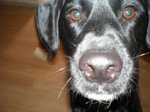I spent my five-year tenure as a graduate student studying the yeast version of the human enzyme called AMPK. The most widely prescribed medications used to treat patients with Type II Diabetes activate AMPK. Ostensibly, the goal of my research and that of others investigating this same enzyme has been to better understand the biochemical processes whereby these medications are therapeutic for Type II Diabetics.
 Certainly, however, I am not alone in having harbored ulterior motives in making AMPK the center of my (professional) existence—motives which I have been made ashamed to admit by the liberally/ conservatively biased media and political elite which maintain that no gain can come in the absence of pain. In truth, I outwardly maintained the guise of searching for the cure for diabetes, while I toiled under cover of night on a quest for the holy grail of translational biomedical research: an instant fitness drug. Apparently, Ron Evans shared this secret passion.
Certainly, however, I am not alone in having harbored ulterior motives in making AMPK the center of my (professional) existence—motives which I have been made ashamed to admit by the liberally/ conservatively biased media and political elite which maintain that no gain can come in the absence of pain. In truth, I outwardly maintained the guise of searching for the cure for diabetes, while I toiled under cover of night on a quest for the holy grail of translational biomedical research: an instant fitness drug. Apparently, Ron Evans shared this secret passion.There have been clear indications for some time that the compound designated AICAR directly activates AMPK, my favorite enzyme, but only since the recent publication in the journal Cell authored by the venerable Ron Evans and colleagues at San Diego’s Salk Institute has become clear that this AICAR-mediated AMPK activation represents the most significant biomedical breakthrough of our (all?) time.
Mice medicated with AICAR for one month performed as well in fitness tests as their siblings did that had been sweatin’ to the oldies on mice treadmills during that same month. The AICAR-treated mice had lost weight and were legitimately healthier than they were before the study began. Unlike many other diet medications which act by suppressing appetite or speeding up body metabolism, AICAR actually tricks cells into thinking they have exercised—that they have been burning energy (ie calories!) and ought to continue doing the same. In short, AICAR is exercise in a pill, and Ron Evans and friends have proven it.
It did not take long for critics of this miracle drug to cry foul—accusing anyone who would consider taking such a medication of supreme laziness. Skeptics decry would-be AICAR consumers as cheaters. I would like to provide an opposing viewpoint.
For people too lazy to eat their vegetables (or pre-menopausal women too lazy to drink their milk), we provide dietary vitamin and mineral supplements—in the form of a pill.
For people too lazy to get the recommended eight hours of sleep a night, we provide liquid energy—in the olden days, it was in the form of a cup o’ joe or a diet coke; in these newfangled modern times we offer Starbucks Skinny Venti Triple Café Mochas (I perk up at just the mention!).
For people too lazy to learn their ABC’s and 123’s on their own, we provide pre-fabricated encapsulated learning experiences—in the form of a formal public education.
For people too lazy to manually control their labored breathing or exercised-induced respiratory challenges, we provide asthma medications—in the forms of aerosols and pills.
You may not know this about me, but I am just such a person who has at times been too lazy to eat an adequate supply of vegetables, too lazy to get all the sleep I need, too lazy to be a self-taught man, and too lazy to manage my asthmatic tendencies, and I have benefited from each of the above mentioned supplemental nutritional/ alertness/ educational/ respiratory enhancements.
Listen. I am no professional athlete, nor do I continue to aspire to be one. Unless I receive a (practically) unexpected last-minute call from the US Gymnastics Team (I’m a little past my prime), I am unlikely to ever participate in any activity which will preclude me from consuming fitness-enhancing chemicals. I will never engage in any function which will demand effort-derived wellness.
Exercise supplements (nay, replacements!) promise only to improve the quality of my life. When AICAR becomes available to the general public, I just might be first in line for this silver bullet. Think of all the time I will then have that was formerly (ha!) spent exercising-- that will then be freed up for other productive activities that will have a more substantial benefit for all mankind, chiefly further scientific research (any special requests for my next topic of investigation?) and blogging.
Call me a cheater if you will. But if you do, you must also call Christopher Columbus a cheater for using a ship to reach America, Helen Keller a cheater for using her hands to “hear” people speak, and George Bush a cheater for using hanging chads to reach the high office of the Presidency of the United States.
God Bless America!
* Ron Evans image accessed from the Salk Institute website





